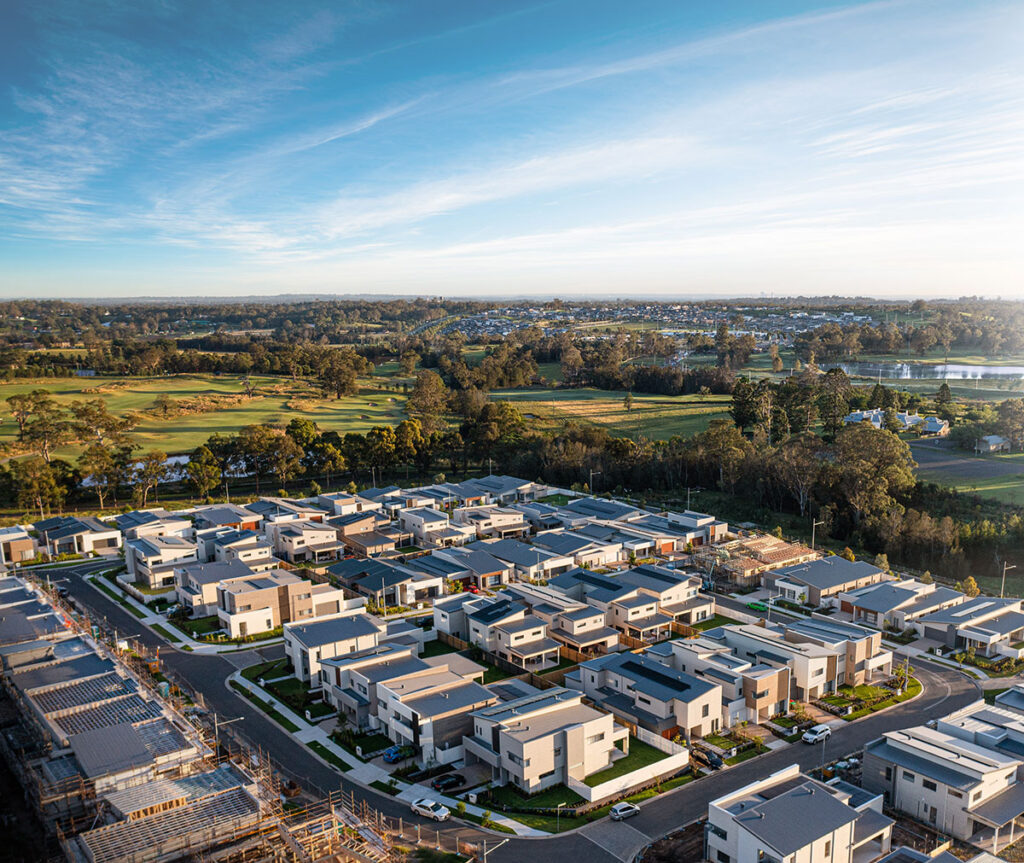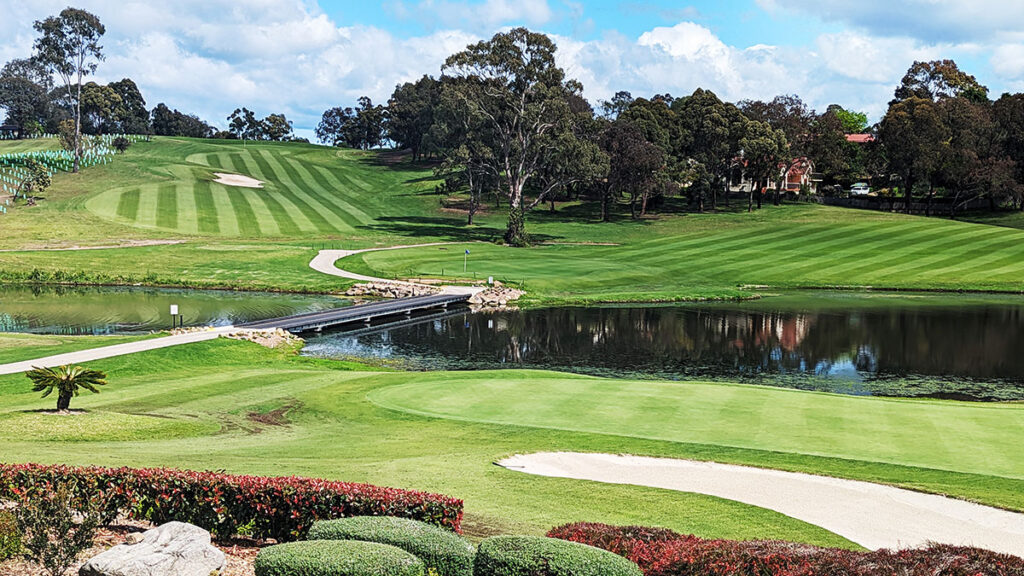The Macarthur region of Sydney’s south-west is where you will find bustling Campbelltown, historic Camden and a diverse range of top-shelf golf courses.
Back in the day, a drive down Camden Valley Way used to be a single-lane journey accompanied by the sight of scattered eucalypts, sporadic herds of Aberdeen Angus cattle and the odd solitary horse. How times change. In less than 20 years, Camden Valley Way has become a major arterial thoroughfare through a teeming metropolis. The Macarthur region has quickly become the fastest-growing area of metropolitan Sydney.
The certified population of Macarthur is 343,041, however it’s likely to approach 400,000 by the 2026 Census – by which time it could be regarded as the 10th largest urban area in Australia. The most recent population growth has occurred along Camden Valley Way, which has spawned New South Wales’ newest state electorate of Leppington.
Macarthur is comprised of three local government areas in Greater Sydney’s south-west: City of Campbelltown, Camden Council and Wollondilly Shire. It covers 3,067 square kilometres from the suburb of Glenfield in the north to Yanderra in the south, Appin to the east and Nattai to the west.
The region acquired its name from John and Elizabeth Macarthur who are regarded as pioneering founders of the Australian Merino wool industry. As a politician, John Macarthur is said to have been instrumental in the so-called ‘Rum Rebellion’ against NSW governor William Bligh in 1808.
Another growth spurt is likely as a result of Western Sydney International Airport, currently under construction at Badgerys Creek and scheduled to open in 2026. Located 13 kilometres from Leppington, Sydney’s second major airport will operate curfew-free 24 hours a day. It’s been reported the ‘Aerotropolis’ will contribute as many as 200,000 new jobs in the surrounding ‘Western Parkland City’.
The new airport will add to the appeal of the family-orientated south-west growth corridor. Local residents have easy access to refurbished major shopping centres at Macarthur Square and Narellan Town Centre, while the historic township of Camden has heritage buildings, boutique shops and a variety of dining options. The Australian Botanic Garden Mount Annan is a hidden gem as a family picnic location with manicured lawns, tranquil lakes and walking trails spread across 416 hectares. Gledswood Homestead & Winery is famous for farm days, high teas and cellar-door experiences. Nearing completion is the $34.65-million Campbelltown Billabong Parklands development that is anticipated to attract 500,000 visitors annually. The focal point will be a 1,600sqm swimming lagoon that will be interconnected with a children’s pool, cascades, streams and a zero-depth splash play area.
With regard to sport, the men’s A-League realised the region’s potential growth and granted Macarthur FC with the most recent licence to compete in Australia’s premier soccer competition. In the NRL, the Wests Tigers play a few of their home fixtures at Campbelltown Sports Stadium. The Greater Western Sydney Giants also have a presence, as seen by the ever-increasing number of AFL posts during winter months. Menangle Park paceway is the state’s home of trotting after the NSW Harness Racing Club relocated there when it sold Harold Park in Glebe to property developer Mirvac for $185 million.
Golfers are more than well catered for by a diverse range of top-shelf courses. The best of which is Lakeside Golf Club Camden, originally designed by Peter Thomson/Mike Wolveridge/Ross Perrett in 1993 purely as a pay-for-play, resort-style course for a Japanese consortium. Then known as Camden Lakeside, it absorbed members from neighbouring Camden Valley Golf Resort (née Rugby League Country Club) when its 27 holes were sold for property development.
Initially, the merged Lakeside club struggled to survive until a fortuitous change of circumstances. The local population exploded with new residential developments sprouting up along Camden Valley Way in the suburbs of Leppington, Denham Court, Gledswood Hills, Gregory Hills, Catherine Field, Oran Park and Harrington Park. Meanwhile, Wests Group Macarthur took over management of Lakeside in 2012. With a net profit before tax of $19.25 million last financial year, Wests Group has invested many millions into Lakeside’s golf-club operations as well as the local community.
But that’s only part of the Lakeside story. The sale of Camden Valley by its prominent NSW leagues club owners involved a land-swap deal whereby parts of the original Lakeside course could be annexed for the adjoining Gledswood Hills residential development.
Wests Group averted a potential disaster by engaging experienced Sydney course architect James Wilcher to reconfigure the layout. Wilcher, along with construction firm Flemming Golf, built four completely new holes, re-aligned others and remodelled 14 greens. (Greg Norman Golf Course Design/Atlas Golf Services previously built four new holes to replace those consumed by the residential development.)
The new Lakeside is a pleasure to play with fast-running couch fairways that add a ‘linksy’ feel. Wilcher replaced the original flat putting surfaces with new green complexes that feature T-1 creeping bentgrass putting surfaces and the trademark pot-style bunkers synonymous with five-time Open champion Thomson.

Over time, the golf-course ambience should by complemented by the upmarket residential development. Norman Estates At Gledswood Hills is Sekisui House’s final release of land in the award-winning, master-planned community. Scheduled for completion in 2025, it will feature 190 architecturally designed Shawood homes surrounding a nine-hole par-3 course designed by Norman, which shall re-open once Wests Group establishes a clubhouse. House-and-land packages are selling from $1.4 million.
In a separate development, Stockland has partnered with Sekisui House to sell about 300 blocks of land. Lakeside at Gledswood Hills is being released in five stages with land starting from $619,000.

Another facility with a benevolent owner is Campbelltown Golf Club at Glen Alpine, just south of Macarthur Square. Campbelltown Catholic Club stepped in to save the financially embattled golf club in 2010 and it’s been on an upward trajectory ever since. Last year the Catholic Club – which has more than 50,000 members – signed a long-term lease with Campbelltown City Council to manage the golf course.
Glen Alpine was one of the first residential golf estates built in Australia. In the late 1970s, construction giant Landlease provided funding for building the Campbelltown golf course designed by Bob Harrison. It’s a cracking layout routed up and down dale with some heroic carries and dramatic elevation changes (5,626 metres, par 70). The pure bentgrass greens and kikuyu fairways are superbly maintained by the greenkeeping staff of five led by superintendent David Simpson (whose father John was the long-time super at Camden Valley).
Campbelltown’s most intriguing hole is the 18th, a 376-metre par 4 that doglegs left across a large lake that comes into play on three holes. The approach shot across the water is tricky due to a downhill lie as the fairway slopes towards the lake. Apparently, Lendlease deemed the approach too difficult and ordered Harrison to add a second green that wouldn’t require a water carry. He obliged but contoured the putting surface with humps and swales in contrast to other greens on the course. And therein lies the tale as to why it became known as ‘Harrison’s Revenge’.

Camden Golf Club at Narellan has benefitted from the huge population surge in Sydney’s south-west growth corridor. During COVID, the club invested substantially into the clubhouse precinct by erecting an outdoor marquee and constructing a children’s play area. The refurbishments have been well supported by residents in the burgeoning new suburbs of Elderslie and Spring Farm.
However, to accommodate the clubhouse extension, it required turning Camden’s short par-4 ninth hole into a 202-metre par 3, which resulted in the 5,893-metre layout being reduced to a par 71. “Creating an outdoor facility for family and friends was the best thing the club did. It’s put Camden Golf Club on the map in terms of bringing people to the venue,” says PGA professional Stuart Meani. Future clubhouse profits will be invested gradually into course improvements as part of a recently adopted masterplan from architect Richard Chamberlain. Camden superintendent Justin Bradbury has already overseen the installation of new bunkers with Capillary Concrete lining for better drainage.
With the Blue Mountains as a scenic western backdrop, the Camden course has plenty of character and history. Two of John Macarthur’s employees were original owners of what is now Camden Golf Club. Studley Park House lies within the property and the mansion casts a somewhat haunting presence with its dilapidated art deco exterior. Commissioned in 1888 and once used as stables, a grammar school and an army base, the house would make a great film set for a reproduction of the Charles Dickens novel Great Expectations.
During the 1930s, a former owner of Studley Park House engaged five-time NSW Amateur champion Eric Apperly to design the original nine holes. The current layout has wide kikuyu fairways and small creeping bentgrass greens. Most of these putting surfaces slope from back to front and their slippery nature places a premium on where to miss with approach shots. It’s a formidable challenge, especially for contestants at the Macarthur Junior Masters, which is held in conjunction with Campbelltown Golf Club each June long weekend.
Macquarie Links International Golf Club was part of the residential golf boom in Australia at the turn of the century. Monarch Investments Group developed land next to the Ingleburn industrial estate and engaged the late Robin Nelson to design the 6,208-metre, par-72 layout that hosted the NSW Open in 2003.
The departure of Macquarie Links from Australia’s Top 100 Courses coincided with a change of ownership after Monarch’s exit. While it appears in the ‘Next Top 100’ (courses ranked 101-200), the conditioning, state of bunkers and general upkeep needs to be addressed.
Nevertheless, Macquarie Links is a ripping layout that has a linksy feel with firm, running fairways. The front nine is routed through part of the security-patrolled gated community. The back nine descends onto lower lying land where it loops around a riparian wildlife corridor. The par-3 11th hole over a ravine is tantalising, the slender par-5 12th is controversial for its out-of-bounds fence close to the left, while the par-3 15th is a brutal gem.
Wilton’s Bingara Gorge Golf Course will add to Macarthur’s golf scene upon the opening of all 18 holes. Just nine of the holes designed by Graham Marsh are currently playable because the proposed bridge linking both nines was delayed due to environmental concerns. New owner Metro Property submitted a development application for bridges to Wollondilly Shire Council in August. Pending council approval, it’s anticipated the construction will be completed in 18 months. More than half of the 1,800 homes have been built in the Bingara Gorge community, which is located 33 minutes’ drive from Wollongong Beach.

Gateway to Macarthur
It would be remiss to exclude Brighton Lakes Recreation & Golf Club from a snapshot of Macarthur golf as it’s located in the transport hub of Moorebank on the banks of the Georges River. The 18-hole layout straddles the M5 Motorway, the thoroughfare connecting Sydney’s eastern suburbs with the city’s outer south-west.
The former New Brighton Golf Club was in dire straits until it entered a Project Delivery Agreement (PDA) with property developer Mirvac that involved a land transfer with Liverpool Council to open up part of the Georges River foreshore for public use.
Mirvac developed a 306-lot estate on what was the site of the old clubhouse, first, ninth, 10th and 18th holes. The community focal point is the majestic, three-storey clubhouse designed by Altis for about $20 million. The 4,500sqm clubhouse has stunning views over the water-fronted, par-3 18th and can accommodate 600 people.
Meanwhile, course architect Bob Harrison was engaged to rework four holes and design seven new holes on the southern side of the M5 Motorway where New Brighton had previously bought land from the old Greenwood golf course. After re-opening in 2019, the whole project has been a resounding success and enabled Brighton Lakes to secure its long-term viability.



